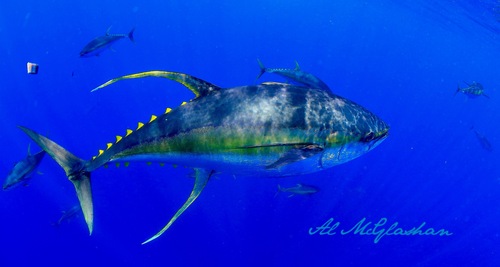
Yellowfin Tuna
The Bluefin Tuna (Thunnus) are among the largest, fastest, and most commercially valuable fish in the ocean. These apex predators play a crucial role in marine ecosystems. Their impressive size, speed, and migratory habits have fascinated humans for centuries.
5 9 years
Lifespan
240 cm
Length
Near Threatened
Conservation Status
75 km/h
Swimming speed
Carnivorous, Planktivorous
Diet
Highly Migratory
Migration
Appearance Overview
The Bluefin Tuna is renowned for its large, streamlined body, built for speed and endurance.
Color
Dark metallic blue on top, with a silvery-white underside
Body Shape
Torpedo-shaped body
Fins
Two dorsal fins, the first depressible into a groove; small finlets running from dorsal and anal fins to the tail
Length
Up to 10 feet (3 meters) commonly, but can reach up to 13 feet (4 meters)
Weight
Typically up to 550 lbs (250 kg), but can reach over 1,500 lbs (680 kg)
Diet
Carnivorous, feeding on a variety of fish, squid, crustaceans, and eels.
Feeding Behavior
Highly active predator, using speed and agility to hunt. They often feed in coordinated schools, especially when younger.
Social Behavior
Forms large schools, particularly during migration and spawning. Shows complex social behaviors within schools.
Commercial Relevance
Extremely high value, especially in sushi and sashimi markets, where it is considered a delicacy.
Conservation measures
Subject to international fishing quotas, catch limits, and monitoring programs. Marine protected areas also play a role.
Status
Varies by species: Atlantic Bluefin Tuna - Endangered; Pacific Bluefin Tuna - Vulnerable; Southern Bluefin Tuna - Critically Endangered
Threats
Overfishing is the primary threat. Other threats include bycatch in fishing gear, habitat degradation, and climate change.
Habitat Distribution
Depth Range
0-1,000 meters, but most commonly found in the upper few hundred meters
Geographic Range
Atlantic Ocean, Pacific Ocean, Indian Ocean, and Mediterranean Sea
Preferred Environment
Temperate and subtropical waters; open ocean (pelagic), often near continental shelves and slopes
Reproduction and Life Cycle
Breeding Habits
Spawns in warm waters, with major spawning grounds in the Mediterranean Sea and the Gulf of Mexico (Atlantic Bluefin). Spawning is typically seasonal.
Development Stages
Eggs hatch into larvae, which develop rapidly in plankton-rich waters. Juveniles grow quickly, eventually reaching adult size and maturity.
Fecundity
Highly fecund; females can produce millions of eggs per season (up to 30 million), depending on their size and condition.
Maturity Age
Varies by species; Atlantic Bluefin Tuna typically mature between 4-8 years, while Southern Bluefin Tuna may take longer.
Faqs about Yellowfin Tuna
Where are Bluefin tuna found?
Bluefin tuna are found in the Atlantic, Pacific, and Indian Oceans, as well as the Mediterranean Sea.
How long do Bluefin tuna live?
Bluefin tuna can live up to 40 years, although this varies by species.
Do Bluefin tuna migrate?
Yes, they undertake long migrations across oceans for feeding and spawning.
Are Bluefin tuna warm-blooded?
Bluefin tuna are warm-blooded, which allows them to maintain a higher body temperature than the surrounding water, aiding in speed and endurance.
How fast can Bluefin tuna swim?
They can reach speeds of up to 43 mph (70 km/h) in short bursts.
How many eggs do they lay?
A female can release up to 30 million eggs per spawning season.
How much does a bluefin tuna cost?
The price varies significantly depending on the quality, size, and market, but can fetch tens of thousands of dollars for a single fish, even reaching millions in rare cases.
Where do they spawn?
They spawn in specific areas like the Mediterranean Sea and the Gulf of Mexico (for Atlantic Bluefin).
What do bluefin tuna eat?
They primarily feed on fish, squid, and crustaceans.
When do they reach maturity?
They reach maturity at different ages depending on the species, typically between 4-8 years.
Copyright @ Nature Style Limited. All Rights Reserved.
 English
English